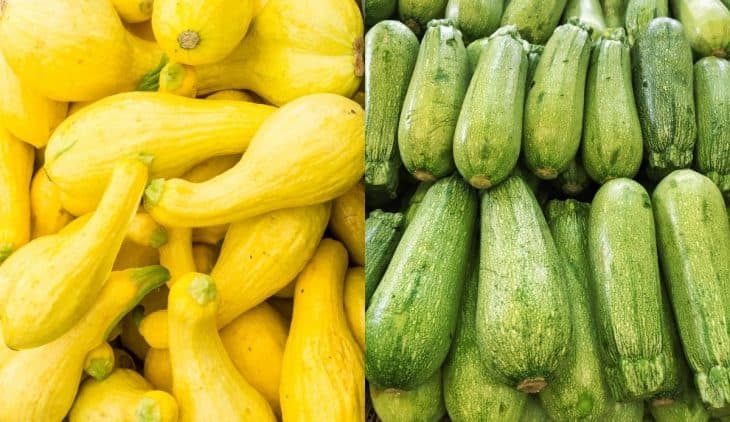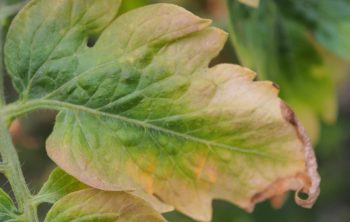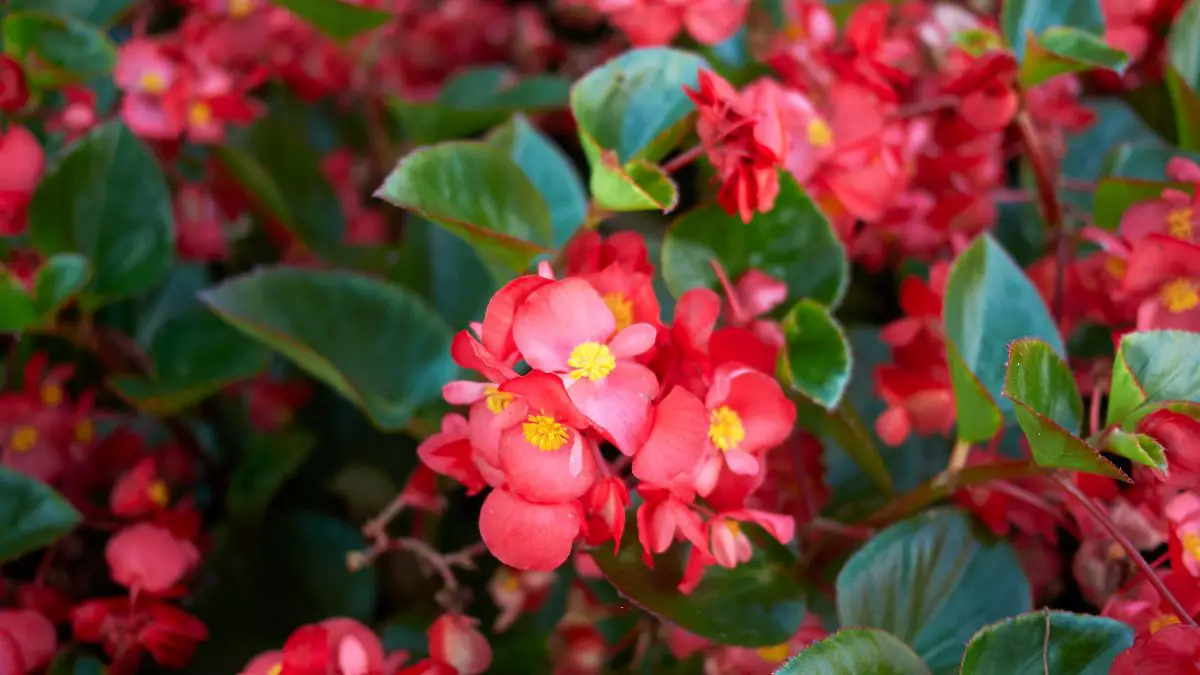Zucchini and yellow squash are both popular fruits, though culinary wise they are often referred to as vegetables by how they are prepared. However, many people don’t know the differences between yellow squash vs zucchini. Though they do share many similarities, they are also quite different.
Zucchini and yellow squash are among some of the easier plants to grow. They make a great addition to your garden, no matter if you are an expert or beginner. There are also so many great dishes you can make with these two fruits.
Yellow Squash Vs Zucchini
Both yellow squash and zucchini are a type of summer squash. Though all zucchini is considered a type of squash, not all squash is zucchini.
Squash refers to a type of plant species within the gourd family. There are two categories of squash: winter, and summer.
Common winter squash includes butternut, spaghetti, and acorn squash. They have hard skins that are unedible and include tough seeds.
There are several different types of summer squashes that come in many different shapes and sizes. They can be long, round, flat, straight, or tapered. Unlike winter squashes, they have soft, thin skin that is completely edible.

Summer squashes, including zucchini and yellow squash, can be eaten raw or cooked. They tend to have mild flavors that can even be slightly sweet. They can be eaten alone or incorporated into many other types of dishes, both sweet and savory.
Due to their similar appearance, zucchini and yellow squash are often confused. Though they are similar in many ways, the two varieties of squash also differ. They can not always be used interchangeably due to their differences.
Summer squash grows quickly and is often easy to maintain. They are packed full of many important nutrients, making them a very healthy addition to your diet. Other common varieties include Patty Pan, Cousa, and Zephyr squash.
Green Zucchini
Green zucchini is the most recognizabletype of zucchini. It has a rich, deep green color with a long, sometimes tapered shape. The flesh is white and has a mild flavor that can be slightly sweet.
It can generally be found all year round in grocery stores, but its peak season is in summer. Green zucchini has a soft, thin skin that you can eat or peel off, depending on your preference. You can eat it raw, fried, sauteed, grilled, roasted, and steamed.
Green zucchini squash is also a popular addition to bread, cakes, cookies, and muffins. It provides baked goods with a wonderful moist texture without changing the flavor. You won’t be able to notice that zucchini was added to baked goods, however, you will be able to taste how delicious it makes them.
It also tends to grow in abundance, which is why it is so great to add to your baked goods. It also makes amazing fritters, salads, pasta dishes, and much more. No matter how you prepare it, it is a great addition to have in your kitchen.
Yellow Zucchini
Yellow zucchini is not to be confused with yellow squash, as they are two different things. Sometimes called golden zucchini, it does not taper at the end like other summer squashes.
Yellow zucchini also has soft, thin skin that you can eat or peel off if you like. It has white flesh and is typically slightly sweeter than green zucchini. Their cylindrical shape makes them ideal for spiralizing.
Yellow Zucchinis can often be used interchangeably or with green zucchinis in recipes. They are great for baking, roasting, frying, pasta, sauteing, grilling, and steaming. They also taste delicious when eaten raw and are great for salads and other vegetable dishes.
Survival Garden Seeds Zucchini & Squash Collection Seed Vault – Non-GMO Heirloom Seeds for Planting
Yellow Squash
Though both green and yellow zucchinis are squash, yellow squash is not a zucchini. Yellow squash comes in two different types, straight neck, and crookneck neck. Both varieties have fatter bottoms that then taper as the neck curves.
The skin is thin and can be smooth or slightly bumpy, though no matter the texture, it is edible. Their flesh is a creamy white color and they tend to have larger seeds than other types of summer squash.
Crookneck yellow squash, which is notable for its distinctive bent neck, tends to have waxier skin than the other type. It is generally harvested once it has a more mature crookneck in order for the optimum flavor and texture.
Straightneck yellow squash tapers at the neck but does not curve. It is best when it is harvested at around six inches long or slightly shorter as this is when it will have its best flavor and texture.
Summer squash tastes great when you roast, grill, fry, saute or steam it. It also tastes wonderful when it is added with zucchini and baked as a casserole. It has a mild flavor, but it is not as slightly sweet like zucchini is.

FAQs
Are yellow squash and zucchini the same?
No. The difference between them is that zucchini is a member of the Cucurbit family (squash and pumpkin), while yellow squash belongs to the summer squashes (such as the patty pan, and summer squash). Both of these vegetables can be used in many different dishes such as soups, stews, casseroles, and salads.
They are both delicious and easy to grow. Zucchini is best eaten when it is young, as its flavor becomes more intense as it ages. Yellow squash can be eaten in a variety of ways, but its most popular method is grilling. Both of these vegetables are very low in calories and fat. If you are looking for ways to add variety to your diet, these two vegetables are a great choice.
What nutrients do they have?
Zucchini and yellow squash are high in fiber and potassium. These nutrients help regulate blood sugar levels and help prevent constipation. Zucchini and yellow squash are also great sources of vitamins C, A, B6, and K. It is important to get these nutrients in your diet because they will boost your energy and help you stay healthy. Try to eat them every day, but if you can’t find time, at least eat them several times a week.
Zucchini and yellow squash are great low-calorie foods to eat while losing weight. They contain almost no fat and are low in calories. It is low in calories, has a high water content and contains a number of vitamins and minerals.
They have a lot of fiber. Zucchini has much more of it than squash because it’s lower in carbs and higher in protein.
If you are looking for something that will boost your immune system, squash is the way to go.
Can you eat raw zucchini and yellow squash?
Zucchini and yellow squash are among the most versatile vegetables on the planet. They can be grilled, fried, roasted, baked, boiled, sautéed, pureed into sauces, or chopped and added to soups.
You can eat them raw or cooked (although some people are very allergic to it). I personally would not consume it as much as other veggies, as it has a high oxalic acid content, which can cause kidney stones.
When is the best time to plant zucchini and yellow squash?
The best time to plant zucchini and yellow squash depends on your climate. Planting in late fall or winter can give you a good crop in the spring. Zucchini and yellow squash plants grow best in warmer weather. They will be more productive when temperatures are above 60°F. In cooler temperatures, they tend to produce less fruit and have a shorter growing season.
Zucchini plants are very sensitive to heat and drought. They need a lot of water during the summer months to keep from wilting.
I would recommend you get some small, shallow pots or planter boxes and put your zucchini plants in them. They will grow a lot faster than in the ground.
Understanding Summer Squashes: Knowing the Difference Between Zucchini vs Yellow Squash
Both zucchini and yellow squash are a variety of summer squash. They are notable for their mild flavor and soft, thin skins, which differ from the winter varieties of squash. Both of them grow in abundance during the summer season and are full of many beneficial nutrients, making them a great addition to your garden.
Zucchini can be either green or yellow. Both the green and yellow types can generally be used interchangeably, with the yellow type often being slightly sweeter. They are a great choice for using in both sweet and savory recipes, thanks to their mild flavors and moisture they bring to baked goods.
Yellow squash can be either straight neck or crookneck. Both types have thin skin, that can be anywhere from smooth to slightly bumpy in texture. They tend to have larger seeds than other varieties of squash and are also great for cooking in many different savory dishes.
Do you have any questions regarding the similarities and differences between yellow squash vs zucchini? If so, please ask any questions regarding these two popular varieties of summer squash in the comment section down below.

Anna is an avid gardener who loves the outdoors and spending time in nature. She has been gardening since she was a child and has a passion for growing her own food and flowers. She enjoys experimenting with different types of plants and techniques to create beautiful and bountiful gardens. She is always trying to learn more about gardening and is an active member of her local gardening club. She loves to share her knowledge and experience with others and is always willing to lend a helping hand. Anna believes that gardening is a great way to bring people together and foster a sense of community.





